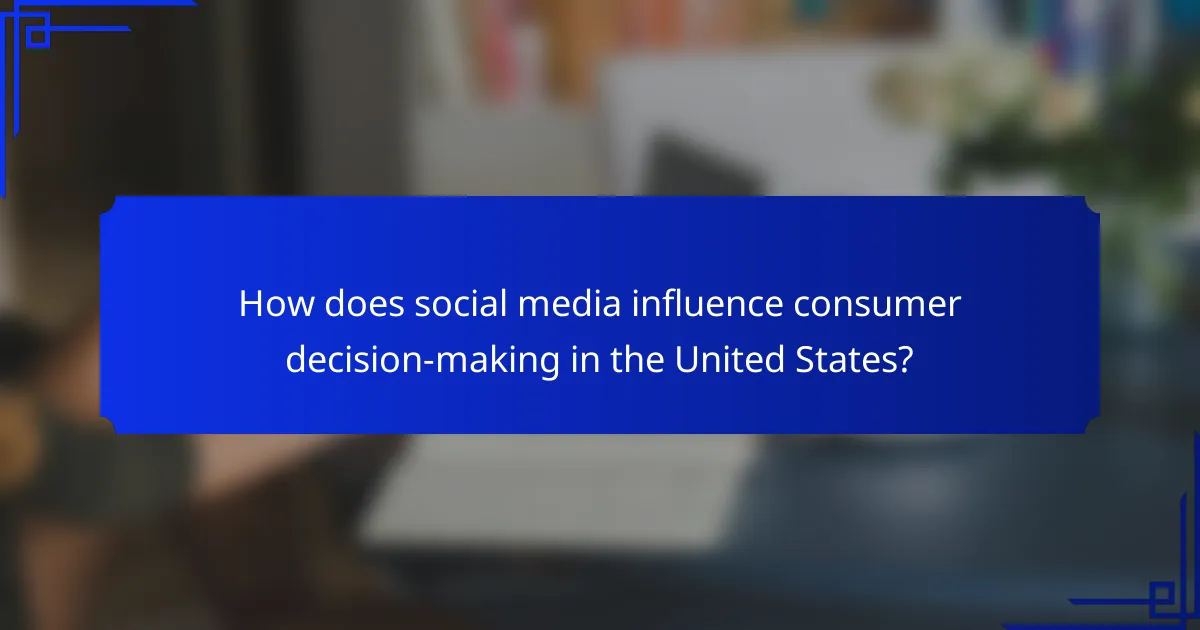Social media plays a pivotal role in influencing consumer decision-making by shaping perceptions and preferences through engaging content and interactions. Users frequently turn to these platforms for product recommendations and reviews, which can significantly impact their purchasing decisions. To enhance consumer engagement, brands can employ strategies such as interactive content and targeted advertising, fostering deeper connections and driving loyalty.

How does social media influence consumer decision-making in the United States?
Social media significantly impacts consumer decision-making in the United States by shaping perceptions and preferences through various forms of content and engagement. Users often rely on social platforms for product recommendations, reviews, and trends, which can directly affect their purchasing choices.
Impact of user-generated content
User-generated content (UGC) plays a crucial role in influencing consumer decisions. Reviews, photos, and testimonials shared by other consumers create a sense of authenticity and trust. Many shoppers consider UGC as more reliable than traditional advertising, leading to increased engagement and higher conversion rates.
For example, brands that encourage customers to share their experiences on social media often see a boost in sales. A simple hashtag campaign can generate thousands of posts, showcasing real-life usage of products, which can sway potential buyers.
Role of influencer marketing
Influencer marketing is a powerful tool in shaping consumer behavior on social media. Influencers, who have established credibility and a loyal following, can effectively promote products and services to their audience. Their recommendations often carry more weight than traditional advertisements, as followers tend to trust their opinions.
Brands collaborating with influencers can target specific demographics, enhancing their reach. For instance, a beauty brand may partner with a popular makeup artist on Instagram to showcase new products, leading to increased brand visibility and consumer interest.
Effect of social proof on purchases
Social proof significantly affects purchasing decisions by leveraging the behavior of others to validate choices. When consumers see that a product is popular or highly rated by peers, they are more likely to consider it for their own needs. This phenomenon is particularly evident in online shopping, where ratings and reviews can make or break a sale.
For example, products with high ratings and numerous reviews on platforms like Amazon often experience faster sales. Retailers can enhance social proof by displaying customer ratings prominently, showcasing best-sellers, or highlighting user testimonials on their social media channels.

What strategies enhance consumer engagement on social media?
Effective strategies for enhancing consumer engagement on social media include utilizing interactive content, leveraging targeted advertising, and building community through brand storytelling. These approaches not only capture attention but also foster deeper connections with audiences, driving brand loyalty and sales.
Utilizing interactive content
Interactive content, such as polls, quizzes, and live videos, actively involves consumers and encourages participation. This type of content can significantly increase engagement rates, as users are more likely to interact with posts that require their input or feedback.
For example, brands can create fun quizzes related to their products or services, prompting users to share results with their networks. This not only boosts engagement but also extends the brand’s reach organically.
Leveraging targeted advertising
Targeted advertising allows brands to reach specific demographics based on user behavior, interests, and location. By tailoring ads to the right audience, companies can improve click-through rates and conversion rates, making their marketing efforts more efficient.
For instance, a clothing retailer can use targeted ads to reach young adults interested in fashion trends, ensuring that their promotional messages resonate with the intended audience. Utilizing platforms like Facebook and Instagram, brands can refine their targeting to maximize engagement.
Building community through brand storytelling
Brand storytelling creates a narrative that resonates with consumers, fostering a sense of community and belonging. By sharing authentic stories about the brand’s values, mission, and customer experiences, companies can create emotional connections that enhance engagement.
For example, a sustainable brand might share stories about its eco-friendly practices and the impact on local communities. This not only engages consumers but also encourages them to become advocates for the brand, sharing their own experiences and expanding the community further.

How do demographics affect social media engagement?
Demographics significantly influence social media engagement by shaping how different groups interact with platforms. Age, gender, and geographic location play crucial roles in determining preferences and behaviors on social media.
Age group preferences
Different age groups exhibit distinct preferences for social media platforms. For example, younger users, typically aged 18-24, often gravitate towards visually-driven platforms like Instagram and TikTok, while older users may prefer Facebook for its community features.
Understanding these preferences can help marketers tailor their content strategies. Engaging younger audiences may require more dynamic and creative content, while targeting older demographics might focus on informative and community-oriented posts.
Gender-based engagement trends
Gender influences how users engage with social media, with notable differences in platform usage and content interaction. Women generally show higher engagement rates on platforms like Pinterest and Instagram, often using these sites for inspiration and community building.
Conversely, men may be more inclined to engage on platforms like Reddit and Twitter, where discussions and news sharing are prevalent. Marketers should consider these trends when designing campaigns to ensure they resonate with the intended audience.
Regional variations in platform usage
Regional differences significantly impact social media platform usage, influenced by cultural norms and internet accessibility. For instance, in Europe, platforms like Facebook and Instagram dominate, while in Asia, apps like WeChat and TikTok are more prevalent.
Understanding these regional variations is essential for global marketing strategies. Companies should adapt their social media approaches to align with local preferences and behaviors, ensuring effective engagement across diverse markets.

What metrics measure social media’s impact on consumer behavior?
Key metrics that measure social media’s impact on consumer behavior include engagement rates, conversion tracking, and brand sentiment analysis. These metrics provide insights into how consumers interact with brands online and influence their purchasing decisions.
Engagement rates
Engagement rates reflect how actively consumers interact with a brand’s content on social media. This includes likes, shares, comments, and overall interactions relative to the number of followers or impressions. A higher engagement rate often indicates that content resonates well with the audience, which can lead to increased brand loyalty.
To calculate engagement rates, divide the total interactions by the total followers or impressions and multiply by 100 to get a percentage. For example, if a post receives 200 interactions from 1,000 followers, the engagement rate is 20%. Brands should aim for engagement rates above 1-3% for effective reach.
Conversion tracking
Conversion tracking measures the effectiveness of social media campaigns in driving specific actions, such as purchases or sign-ups. By setting up tracking pixels or using UTM parameters, brands can link social media interactions directly to conversions on their websites. This data helps assess the return on investment (ROI) of social media efforts.
Commonly, brands use tools like Google Analytics to track conversions from social media. A typical conversion rate for social media can range from 1-5%, depending on the industry and campaign quality. Brands should regularly analyze this data to optimize their strategies and focus on high-performing platforms.
Brand sentiment analysis
Brand sentiment analysis gauges consumer feelings and perceptions about a brand based on social media conversations. This metric helps brands understand public opinion and can influence marketing strategies. Positive sentiment can enhance brand reputation, while negative sentiment may require immediate attention.
Tools like sentiment analysis software can categorize mentions as positive, negative, or neutral. Brands should monitor sentiment trends over time, aiming for a positive sentiment score above 70%. Regularly engaging with customers and addressing concerns can help improve overall sentiment.

How can businesses optimize their social media strategies?
Businesses can optimize their social media strategies by focusing on data-driven decisions, engaging content, and adapting to audience preferences. This involves testing different approaches, utilizing analytical tools, and staying updated with platform changes to enhance consumer engagement and decision-making.
Implementing A/B testing
A/B testing allows businesses to compare two versions of content to determine which performs better. By changing one variable at a time, such as images, captions, or posting times, companies can gather insights on what resonates more with their audience.
For effective A/B testing, ensure that the sample size is sufficient to yield reliable results. Aim for a testing period of at least one week to account for variations in user behavior throughout the week.
Utilizing analytics tools like Hootsuite
Analytics tools like Hootsuite provide valuable insights into audience engagement and content performance. These platforms can track metrics such as likes, shares, comments, and click-through rates, helping businesses understand what content drives consumer interest.
Regularly reviewing analytics can inform future content strategies. Focus on key performance indicators (KPIs) relevant to your goals, such as engagement rates or conversion metrics, to refine your approach effectively.
Adapting to platform algorithm changes
Social media platforms frequently update their algorithms, affecting how content is displayed to users. Businesses must stay informed about these changes to maintain visibility and engagement with their audience.
To adapt, regularly review platform guidelines and best practices. Engage with your audience through comments and direct messages, as increased interaction can help boost your content’s visibility in feeds, regardless of algorithm shifts.

What are the emerging trends in social media marketing?
Emerging trends in social media marketing include the rise of short-form video content, increased use of artificial intelligence for personalized marketing, and a growing emphasis on social commerce. Brands are adapting to these trends to enhance consumer engagement and drive purchasing decisions.
Short-form video content
Short-form video content, such as that found on platforms like TikTok and Instagram Reels, has become a dominant format for engaging consumers. These videos are typically under a minute long and can quickly capture attention, making them effective for brand storytelling and product showcases.
To leverage this trend, brands should focus on creating authentic, entertaining, and visually appealing videos that resonate with their target audience. Regularly posting content and utilizing trending sounds or challenges can help increase visibility and engagement.
Artificial intelligence in marketing
Artificial intelligence (AI) is increasingly being used in social media marketing to analyze consumer behavior and personalize content. AI tools can help brands segment their audiences, predict trends, and automate responses, leading to more effective marketing strategies.
Brands should consider integrating AI-driven analytics to tailor their messaging and improve customer interactions. However, it’s essential to maintain a balance between automation and human touch to ensure genuine engagement.
Social commerce
Social commerce, the integration of e-commerce into social media platforms, is rapidly gaining traction. Consumers can now discover and purchase products directly through social media, streamlining the shopping experience and enhancing impulse buying.
To capitalize on social commerce, brands should optimize their social media profiles for shopping, utilize shoppable posts, and engage with customers through live shopping events. Providing clear product information and seamless checkout options can significantly enhance conversion rates.
